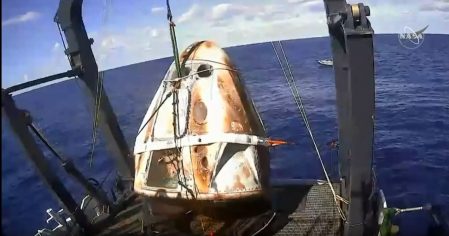SpaceX Crew Dragon Splashdown Marks End of DM1 Flight
A splashdown in the Atlantic Ocean signaled the end of DM1, the first flight of Crew Dragon, the SpaceX spacecraft intended to carry humans to the ISS as part of NASA's Commercial Crew Program. Boeing is also offering a vehicle that will see the start of testing later in 2019 if all goes to plan.
According to a NASA statement:
The mission began March 2, when the Crew Dragon launched from NASA’s Kennedy Space Center in Florida, and racked up a number of “firsts” in less than a week.
- First commercially-built and operated American crew spacecraft and rocket to launch from American soil on a mission to the space station.
- First commercially-built and operated American crew spacecraft to dock with the space station.
- First autonomous docking of a U.S. spacecraft to the International Space Station.
- First use of a new, global design standard for the adapters that connect the space station and Crew Dragon, and also will be used for the Orion spacecraft for NASA’s future mission to the Moon.

SpaceX Crew Dragon Spacecraft DM1 recovered after Demo 1 (DM1) mission
Crew Dragon carried a passenger on this flight test – a lifelike test device named Ripley, which was outfitted with sensors to provide data about potential effects on humans traveling in the spacecraft. After SpaceX processes data from this mission, teams will begin refurbishing Crew Dragon for its next mission, an in-flight abort test targeted to take place this summer. Demo-2, the first crewed test flight, will carry NASA astronauts Bob Behnken and Doug Hurley on the spacecraft’s final flight to certify Crew Dragon for routine operational missions.

 Welcome to AeroSpaceNews.com, the world's first
Welcome to AeroSpaceNews.com, the world's first